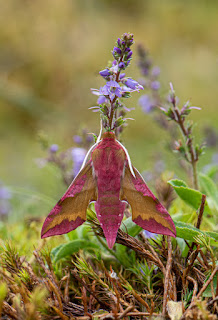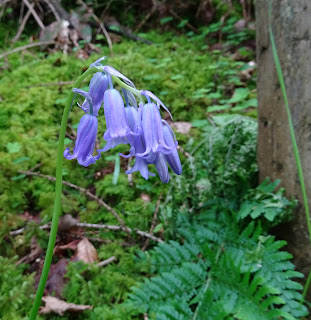Llwyn-derw, Wednesday 5th June 2019
Shropshire was left far behind for a day out in mid-Wales to a farm owned by one of our group. The farm is situated just west of Llanidloes. It consists of meadows that border the River Severn and rises to upland pastures where cattle graze.On arrival we were treated to morning coffee/tea and bara brith. A delightful way to start. (It was raining at the time.)
Sharing the table with the goodies and the centre of attention was a small ant colony that are used as a teaching aid when our host provides training on ants.
Full of liquid and welsh cake we made our way to the meadows where we had been asked to survey.
 |
| Photograph: David Williams |
 |
| Photograph: John Sweetland |
 |
| Photograph: David Williams |
A "down-looker" fly, Rhagio scolopaceus:
 |
| Photograph: David Williams |
Yes, I could have turned it around to prove the point, but I didn't, they really do rest like this.
Finally a bizarre looking weevil, the hazel leaf roller Apoderus coryli:
 |
| Photograph: John Sweetland |
 |
| Photograph: John Sweetland |
 |
| Photograph; John Sweetland |
Amongst the vegetation surrounding this pool we spotted a Large red damselfly Pyrrhosoma nymphula:
 |
| Photograph: John Sweetland |
You may have noticed in the photograph of the pool a jetty. This had a sturdy rail on either side which made excellent perches for us whilst indulging in lunch.
The pool supported a good colony of gypsywort and this plant:
 |
| Photograph: John Sweetland |
Ah!, It's not so simple. Looking at the Natural History Museum's species dictionary there are three water forget-me-nots! Common, Creeping and Short-leaved. Help!!
Near to the pool was our only glimpse of the River Severn. Here it is no more than a wide stream making it hard to believe what it becomes as it flows out to sea.
We moved on to the uplands but before leaving the meadows we paused to look at the view:
And noticed more down-looker flies. But these were not looking down they were far too busy.
 |
| Photograph: David Williams |
On the way we saw a large click beetle with comb-like antennae and two-tone wings -
Ctenicera cuprea.
Nearby there were a couple of Dor beetles making there way across the path.
 |
| Photograph: John Sweetland |
 |
| Photograph: Les Hughes |
 |
| Photograph: David Williams |
We followed a path that went past a small pool where there was a variety of habitats for us to look at which some of us did whilst others searched for the elusive butterfly.
A green hairstreak was located in the grass.
And a Scalloped hook-tip moth on a birch tree.
Climbing a small hill at the side of the pool gave a good view down the small valley that we had just come up.
You will notice the bracken in the foreground. Bracken can be a nuisance and is difficult to control or eradicate but like many pests there are stages in its development when it is attractive, such as a frond that is ready to unfurl.
 |
| Photograph: John Sweetland |
Someone came hurrying back... clasping something between his hands... was it the butterfly.
No.
A small elephant hawk-moth. Such a delightful moth it deserves two photographs here.
 |
| Photograph: David Williams |
 |
| Photograph: John Sweetland |
Nothing seen. Eventually we gave up and made our way back to the start.
But we kept our eyes peeled.
And as we made our way down the valley two or three flighty orange butterflies were spotted. Unfortunately they did not settle.
A couple of us chased them hoping that they would land and we could get a closer up view (to confirm that they were really small pearl-bordered fritillaries).
They settled.
As we got nearer they took to flight again, hither and thither across a patch of very wet vegetation making pursuit difficult.
They settled
As we got nearer they took to flight again …
This passage occurred several times before we gave up and returned to the others, spotting a small copper on the way.
What were the others looking at and photographing in a gorse bush next to the path?
Yes, a small pearl-bordered fritillary!!!!!
 |
| Photograph: David Williams |
 |
| Photograph: David Williams |
What an excellent day.
My thanks to Richard Becker for inviting us to and showing us around his farm and to the photographers David Williams, John Sweetland and Les Hughes for letting me use there excellent photographs.





































No comments:
Post a Comment
Please feel free to comment on this post...